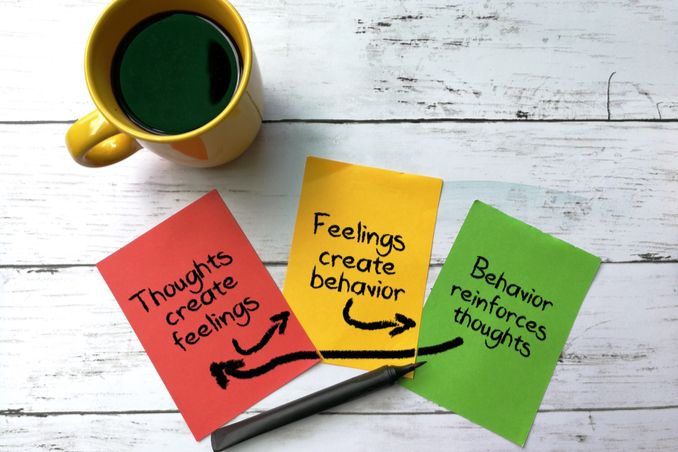Cognitive Behavioral Therapy and Substance Abuse
Table of Contents
A widely used therapy for substance abuse is cognitive behavioral therapy (CBT). Why exactly is CBT so popular in addiction treatment and what does it involve? Find out more about cognitive therapy for addiction to help you or a loved one.
Defining Cognitive Behavioral Therapy
CBT is a psychotherapy treatment that focuses on the interactions between thoughts, feelings, and behaviors. According to this approach, your feelings are affected by your actions and your thoughts, and your feelings in turn affect your actions and thoughts.
During CBT sessions, participants learn how to identify, assess, and respond to negative or dysfunctional thoughts and beliefs. There are several cognitive behavioral therapy techniques to modify thoughts, emotional states, and movements.
The process is a collaborative effort between the therapist and addict, in which therapists seek to understand the individual’s goals and then help them achieve them. The therapist’s function is to listen, teach, and motivate, while the individual learns and implements healthier thoughts, emotions, and behaviors. A key component to CBT, as per the National Institute on Drug Abuse, is to improve patient’s self-control by helping them utilize effective coping strategies.
Support for CBT in the Research Community
CBT is a well-recognized evidence-based approach to addiction recovery. This means that it is proven to provide an addict with a better opportunity for long-term recovery. Several big trials and quantitative reviews support the value of cognitive behavioral therapy for substance abuse, as per a 2010 Psychiatric Clinics of North America journal research review. The journal article cites “substance” as any illicit psychoactive substance or improper use of a prescribed or OTC medication.
Exactly what the CBT intervention looks like is evaluated on a case-by-case basis by a team of medical specialists at a reputable treatment center. CBT can be used individually as part of a person’s treatment plan or in conjunction with other therapies, in group or one-on-one settings, and in outpatient or inpatient environments, depending on a person’s needs and preferences. It is personalized in the sense that each person’s view of the world and beliefs are unique and that each person finds their own relationship with recovery and their own attachment to the results.
In turn, this means CBT is culturally sensitive. By understanding a person’s culture, their strength and motivation can best be understood. So, cognitive behavioral therapy techniques must be framed in a culturally-appropriate way.
Cognitive Behavioral Therapy Techniques
CBT focuses on analyzing and providing insights into the original reason why a person abuses substances. To get to the root of the compulsion, one of CBT’s aims is to help change a person’s unhealthy thought patterns that can lead to self-destructive actions, such as drug abuse, that would obstruct future recovery.
By analyzing negative or flawed thoughts about oneself, others, and the world, a person can come to change their worldview and, in turn, better handle situations. This is an example of cognitive behavioral therapy. Cognitive distortions can include ruminating solely on the negatives, all-or-nothing thinking (seeing scenarios as black and white), and quickly making conclusions without evidence to back thoughts or beliefs.
During CBT sessions, the individual can learn coping strategies that work, based on their unique motivation to use drugs or alcohol. Changing distorted thoughts or “addictive thinking” associated with a high likelihood of substance abuse behaviors can enable a person to resist relapse triggers, cravings, and urges. As this is an active type of therapy, individuals can expect to do cognitive behavioral therapy exercises, either on their own or in a group setting, and homework outside of the therapy sessions.
Additional cognitive behavioral therapy techniques for addiction are problem-solving skills and relaxation techniques. Many cognitive behavioral therapy exercises can be done on one’s own or in a group environment. CBT is relatively short-term, consisting of about 10-20 sessions, as per the Mayo Clinic.
Finding the Best Therapy for the Individual
Given the large body of evidence in support of CBT, it is both effective and accessible. With that being said though, whether this form of therapy is right for you or a loved one struggling with substance abuse depends on the individual. Plus, there are many ways to deliver CBT, including individual or group formats and types of cognitive behavioral techniques.
It is, therefore, important to use a reputable addiction treatment center with health professionals who can match a person with the most suitable therapy type for them. A treatment center that provides the right care for this unique person is integral to recovery.
Why wait another day? Call the dedicated representatives at Find Addiction Rehabs now to speak to our knowledgeable, compassionate team about the best program for you.
Brandon is a highly skilled content writer and behavioral health marketer with over a decade of experience. In his own words: in my work with Find Addiction Rehabs, I have dedicated my expertise to a cause close to my heart – substance abuse recovery. Through my passion for the field, I’ve successfully compiled a track record of crafting compelling content that educates, inspires, and supports those on their recovery journeys.



